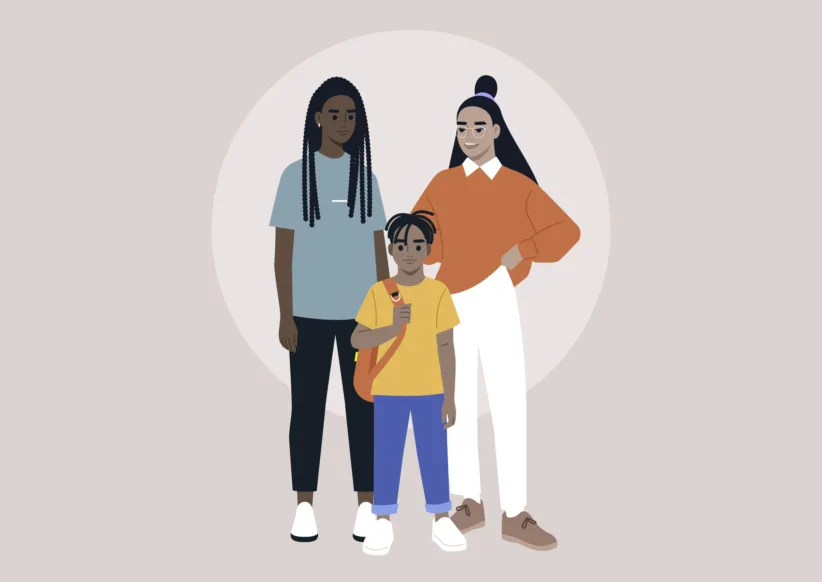“Siblings Without Rivalry,” which offers a compassionate philosophy and practical, no-frills approach to teaching parents how to help their children get along, became a “New York Times” bestseller upon its 1987 publication. Twenty-three years hence, it persists as the definitive guide for desperate parents seeking to quell sibling animosity. We spoke to Faber about the book’s ideas—and how they remain as relevant today as ever.
What’s at the root of sibling rivalry?
There are many roots. The first is the advent of the second child, which signals less for the first child— less time, less attention, and fewer hugs. Everyone is cooing over the new baby, so the question comes up, “Is she worth more?” Then the conclusion is, “If she is worth more, then I’m worth less,” and that translates to the possibility of being worthless, and that’s scary. And so the child fights for his place in the sun.
Is sibling rivalry inevitable?
If you go through the animal kingdom, you’ll find the same dynamic. I think in the case of baby sharks, only one is born because if there are two in the uterus, they’ll fight each other. You’re dealing with some very primal forces here.
In the book, you say that when parents try to reason with their children, it doesn’t work. For instance, saying “You need to be good to one another, because you’ll need each other in the future” is totally ineffective. Why is that?
They’ll say, “I’ll never need him!” It’s meaningless. You need to deal with the present.
So, what would be a step-by-step approach for parents who are trying to resolve a fight between siblings?
Immediately step in and acknowledge their feelings. Then acknowledge the problem aloud, verbally. Acknowledging the problem is not the usual approach; most parents minimize [their children’s] problems. Recognize that their problem is not easy, and give them respect for their difficulties. Say something like, “You really wanted to make a circus!” and “You were especially mad because you had it first!” Having a problem respected and the difficulty stated really settles everybody and refocuses the whole issue from, “I’m going to kill him” to “What should we do now?” And then after the pause that follows, show them a lot of confidence: “Now, you two figure out something that will be fair to you, and fair to you,” as you point to each child. Then you give them privacy to let them settle the argument on their own. When a happy scenario does not ensue, you step in and make your judgment at the time [to resolve the argument].
Did you come up with these ideas through raising your children?
Yes, definitely. There were scenarios, such as “He’s hurting the baby,” or “He’s punching her,” and I remember thinking, “What do I do?” From reading Dr. Spock I learned that if the older one is being mean to the younger one, then that means he needs hugs. He’s attacking the baby because he’s feeling unloved.
There are probably a
lot of parents who have difficulty abandoning the old-school notion of
“tough love.”
There have been enough studies now so that it’s not a mystery
anymore—kids who are reared with parents who are accepting and
supportive of their feelings, as opposed to parents who dismiss feelings
(i.e., “Oh, you’re silly to feel that way!”)— those kids do better at
every level. They have higher self-esteem, they do better in school and
they have better relationships with peers and friends.
Even if there’s no
apparent fighting between siblings, can there still be underlying
rivalry?
You
can get some rivalry going in a second! “Why can’t you be more like
your sister?” There, you’ve just established a life-long enmity. It’s
not hard.
At the
same time, can parents be too focused on treating their children as
equals?
I
never worry about making kids equal. Kids don’t need to be treated
equally; they need to be treated uniquely. They may be seeing each other
in terms of receiving equal treatment, but if you see them in terms of
their individual needs, that’s good enough.
How
do you avoid labeling a child—and making one sibling feel left
out—without neglecting to give him praise for his unique talents?
I never avoid giving
them praise for their skills, but I always do it in terms of their
effort and accomplishment. Anytime you appreciate a child, even if he
has made the all-star team, instead of saying “Oh, what a great athlete
you are,” especially if another child of yours who also enjoys athletics
is standing by, you say, “Wow, all that work you did, all those hours
you spent pitching the ball and playing catch with your friends (be very
specific) really paid off! Did you notice the difference after all of
your work?” And the little one who’s listening says to himself, ‘Well, I
didn’t make it, but what is it my brother did? My mother isn’t saying to him, ‘You’re
the greatest!’ or ‘I can’t wait to tell Daddy and Grandma because
you’re thrilling me to pieces!’” Instead, she’s focusing on what the
child needs to do to get what he wants. The praise comes in terms of
admiring and describing with appreciation the effort he made to get what
he achieved.
Since
your book was published, some of the kids who were raised on it are now
grown up. If your lessons worked on them, what kind of adults would you
expect them to be?
Adults who are comfortable with, and respect, who they are, and
respect people around them for who they are and for the struggles that
life presents all of us.





















